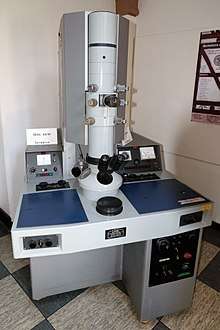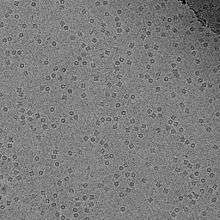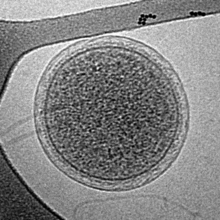Cryogenic electron microscopy
Cryogenic electron microscopy (cryo-EM) is an electron microscopy (EM) technique applied on samples cooled to cryogenic temperatures and embedded in an environment of vitreous water. An aqueous sample solution is applied to a grid-mesh and plunge-frozen in liquid ethane or a mixture of liquid ethane and propane.[2] While development of the technique began in the 1970s, recent advances in detector technology and software algorithms have allowed for the determination of biomolecular structures at near-atomic resolution.[3] This has attracted wide attention to the approach as an alternative to X-ray crystallography or NMR spectroscopy for macromolecular structure determination without the need for crystallization.



In 2017, the Nobel Prize in Chemistry was awarded to Jacques Dubochet, Joachim Frank, and Richard Henderson "for developing cryo-electron microscopy for the high-resolution structure determination of biomolecules in solution."[4] Nature Methods also named cryo-EM as the "Method of the Year" in 2016.[5]
Transmission electron cryomicroscopy
Cryogenic transmission electron microscopy (cryo-TEM) is a transmission electron microscopy technique that is used in structural biology and materials science.
- Cryogenic electron tomography (Cryo-ET), a specialized application of where samples are imaged as they are tilted
- Electron crystallography, method to determine the arrangement of atoms in solids using a TEM
- MicroED,[6] method to determine the structure of proteins, peptides, organic molecules, and inorganic compounds using electron diffraction from 3D crystals[7][8][9]
- Single particle analysis cryo-EM, an averaging method to determine protein structure from monodisperse samples[10]
History
Early development
In the 1960s, the use of Transmission Electron Microscopy for structure determination methods was limited because of the radiation damage due to high energy electron beams. Scientists hypothesized that examining specimens at low temperatures would reduce beam-induced radiation damage.[11] Both liquid helium (−269 °C or 4 K or −452.2 °F) and liquid nitrogen (−195.79 °C or 77 K or −320 °F) were considered as cryogens. In 1980, Erwin Knapek and Jacques Dubochet published commenting on beam damage at cryogenic temperatures sharing observations that:
Thin crystals mounted on carbon film were found to be from 30 to 300 times more beam-resistant at 4 K than at room temperature... Most of our results can be explained by assuming that cryoprotection in the region of 4 K is strongly dependent on the temperature.[12]
However, these results were not reproducible and amendments were published in Nature just two years later informing that the beam resistance was less significant than initially anticipated. The protection gained at 4 K was closer to "tenfold for standard samples of L-valine,"[13] than what was previously stated.
In 1981, Alasdair McDowall and Jacques Dubochet, scientists at the European Molecular Biology Laboratory, reported the first successful implementation of cryo-EM.[14] McDowall and Dubochet vitrified pure water in a thin film by spraying it onto a hydrophilic carbon film that was rapidly plunged into cryogen (liquid propane or liquid ethane cooled to 100 K). The thin layer of amorphous ice was less than 1 µm thick and an electron diffraction pattern confirmed the presence of amorphous/vitreous ice. In 1984, Dubochet's group demonstrated the power of cryo-EM in structural biology with analysis of vitrified adenovirus type 2, T4 bacteriophage, Semliki Forest virus, Bacteriophage CbK, and Vesicular-Stomatitis-Virus.[15]
2017 Nobel Prize in Chemistry
In 2017, three scientists, Jacques Dubochet, Joachim Frank and Richard Henderson, were awarded the Nobel Prize in Chemistry for developing a technique that would image biomolecules.[4]
Scanning electron cryomicroscopy
Scanning electron cryomicroscopy (cryoSEM), is scanning electron microscopy technique with a scanning electron microscope's cold stage in a cryogenic chamber.
See also
References
- Xiao, C., Fischer, M.G., Bolotaulo, D.M., Ulloa-Rondeau, N., Avila, G.A., and Suttle, C.A. (2017) "Cryo-EM reconstruction of the Cafeteria roenbergensis virus capsid suggests novel assembly pathway for giant viruses". Scientific Reports, 7: 5484. doi:10.1038/s41598-017-05824-w.
- Tivol, William F.; Briegel, Ariane; Jensen, Grant J. (October 2008). "An Improved Cryogen for Plunge Freezing". Microscopy and Microanalysis. 14 (5): 375–379. doi:10.1017/S1431927608080781. ISSN 1431-9276. PMC 3058946. PMID 18793481.
- Cheng Y, Grigorieff N, Penczek PA, Walz T (April 2015). "A primer to single-particle cryo-electron microscopy". Cell. 161 (3): 438–449. doi:10.1016/j.cell.2015.03.050. PMC 4409659. PMID 25910204.
- Cressey D, Callaway E (October 2017). "Cryo-electron microscopy wins chemistry Nobel". Nature. 550 (7675): 167. Bibcode:2017Natur.550..167C. doi:10.1038/nature.2017.22738. PMID 29022937.
- Doerr, Allison (January 2017). "Cryo-electron tomography". Nature Methods. 14 (1): 34. doi:10.1038/nmeth.4115. ISSN 1548-7091.
- Nannenga, Brent L; Shi, Dan; Leslie, Andrew G W; Gonen, Tamir (2014-08-03). "High-resolution structure determination by continuous-rotation data collection in MicroED". Nature Methods. 11 (9): 927–930. doi:10.1038/nmeth.3043. PMC 4149488. PMID 25086503.
- Jones, Christopher G.; Martynowycz, Michael W.; Hattne, Johan; Fulton, Tyler J.; Stoltz, Brian M.; Rodriguez, Jose A.; Nelson, Hosea M.; Gonen, Tamir (2018-11-02). "The CryoEM Method MicroED as a Powerful Tool for Small Molecule Structure Determination". ACS Central Science. 4 (11): 1587–1592. doi:10.1021/acscentsci.8b00760. PMC 6276044. PMID 30555912.
- de la Cruz, M Jason; Hattne, Johan; Shi, Dan; Seidler, Paul; Rodriguez, Jose; Reyes, Francis E; Sawaya, Michael R; Cascio, Duilio; Weiss, Simon C (2017). "Atomic-resolution structures from fragmented protein crystals with the cryoEM method MicroED". Nature Methods. 14 (4): 399–402. doi:10.1038/nmeth.4178. PMC 5376236. PMID 28192420.
- Gruene T, Wennmacher JT, Zaubitzer C, Holstein JJ, Heidler J, Fecteau-Lefebvre A, De Carlo S, Müller E, Goldie KN, Regeni I, Li T, Santiso-Quinones G, Steinfeld G, Handschin S, van Genderen E, van Bokhoven JA, Clever GH, Pantelic R (October 2018). "Rapid structure determination of microcrystalline molecular compounds using electron diffraction". Angewandte Chemie. 57 (50): 16313–16317. doi:10.1002/anie.201811318. PMC 6468266. PMID 30325568.
- Cheng, Yifan (2018-08-31). "Single-particle cryo-EM—How did it get here and where will it go". Science. 361 (6405): 876–880. doi:10.1126/science.aat4346. ISSN 0036-8075. PMC 6460916. PMID 30166484.
- Dubochet J, Knapek E (April 2018). "Ups and downs in early electron cryo-microscopy". PLoS Biology. 16 (4): e2005550. doi:10.1371/journal.pbio.2005550. PMC 5929567. PMID 29672565.
- Knapek E, Dubochet J (August 1980). "Beam damage to organic material is considerably reduced in cryo-electron microscopy". Journal of Molecular Biology. 141 (2): 147–61. doi:10.1016/0022-2836(80)90382-4. PMID 7441748.
- Newmark P (30 September 1982). "Cryo-transmission microscopy Fading hopes". Nature. 299 (5882): 386–387. Bibcode:1982Natur.299..386N. doi:10.1038/299386c0.
- Dubochet, J.; McDowall, A.W. (December 1981). "VITRIFICATION OF PURE WATER FOR ELECTRON MICROSCOPY". Journal of Microscopy. 124 (3): 3–4. doi:10.1111/j.1365-2818.1981.tb02483.x.
- Adrian, Marc; Dubochet, Jacques; Lepault, Jean; McDowall, Alasdair W. (March 1984). "Cryo-electron microscopy of viruses". Nature. 308 (5954): 32–36. doi:10.1038/308032a0. ISSN 0028-0836.
.jpg)